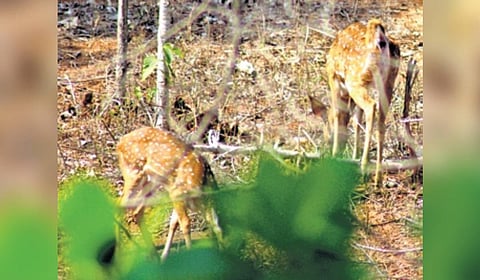

BENGALURU: A healthy prey base is essential to reduce man-animal conflict. While a balance has been noted in most of the tiger reserves and wildlife sanctuaries in the Western Ghats landscape, a concern has been raised incase of Bhadra Tiger Reserve by the Wildlife Institute of India (WII).
In the recently released report- Status of Ungulates in the Tiger Habitats of India- by WII, the team of scientists and experts flagged the low Sambar Deer population in north of Bhadra reservoir, pointing to the need for an investigation pertaining to the connectivity of the population.
The report also pointed to the abundant population of Wild Pigs in southern part of Kali Tiger Reserve, adding that the management should encourage voluntary resettlement of villages inside the reserve forest followed by habitat restoration to make more inviolate space for the ungulate population of the area. They said this will be held increase pre-predator population.
The report stated that the ungulate population is in abundance along with the western part of the Western Ghats. It also noted to the high density of Spotted Deer (Chital) inside and outside tiger reserves. Chital density has found to be the highest in the Bandipur, Mudumalai, Sathyamangalam cluster and its surrounding areas. Its noted to be decreasing in density in the southern areas.
The Sambar Deer density is moderate in most part of Western Ghats. Its density is the highest in the Periyar- Satyamangala Tiger Reserve cluster, forest areas between Mudumalai and Silent valley national park and from Cauvery Wildlife Sanctuary to BRT Tiger Reserve. The forests of Annamalai and Kali have the least density of Sambar Deer.
Qamar Qureshi, co-author of the report said, many tiger reserves have high ungulate population in India but many others like Tadoba, or the forests in Odisha, have low prey and predator population. The forests of Karnataka, Kerala, Tamil Nadu and Madhya Pradesh are doing good. Here the tiger and prey density has reached beyond its carrying capacity. Thus alternate solutions needs to be looked at.
Scientists from WII have also suggested for animal relocation to mitigate conflicts. While it is being done in Madhya Pradesh to a large extent, in Karnataka, small steps towards this is being taken.
A senior Karnataka forest department official, seeking anonymity said: “Work to relocate excessive deer population from the zoo to Kali Tiger Reserve is being done. Similarly work to capture Gaurs from coffee estates and relocate them to less habitated areas like Kali and Bhadra is also being worked upon. Studies on this is being done. A gradual rise in prey base is being observed in these forests has been observed, but to mitigate conflict immediately these measures need to be taken.”
In 2022 the Ministry of Environment, Forests and Climate Change and WII had rated Karnataka’s reserves as the top five in the country, giving it 95% marks, but this comes with a concern of conflict management, the official added.